Search the Special Collections and Archives Portal
Search Results
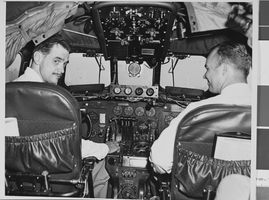
Photograph of Howard Hughes installing radar, Culver City, California, May 03, 1947
Date
1947-05-03
Archival Collection
Description
Description given with photo: "Hughes Pilots Radar-Equipped Plane Culver City, Calif. -- First passenger plane equipped with radar is flown in demonstration May 1st by Howard Hughes (left) and co-pilot R.C. Loomis over Culver City. Pilots using this equipment will be warned of approaching obstacles by lights flashing on radar panel. Two lights (lefts) with 2,000-foot range, are used to guarantee clearance over mountains; two lights (right) with 500-foot range, are a safety device for approaches and landings. Either set of lights warns against approaching aircraft. Trans-World Airline plans to install radar on its passenger planes. Credit (ACME) 5-3-47."
Image

Photograph of a parade for Howard Hughes, Chicago, July 30, 1938
Date
1938-07-30
Archival Collection
Description
Description given on piece of paper attached to the image: "Chicago reception for Howard Hughes after completing his Round the World flight. Hughes is in the center of the car leading the parade."
Image
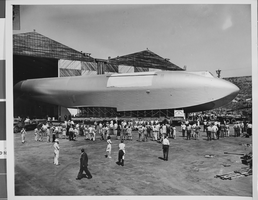
Photograph of Howard Hughes' Hercules, Culver City, California, June 16, 1946
Date
1946-06-16
Archival Collection
Description
Description given with photo: "Hercules Fuselage Leaves Hangar, Calver City, Calif. - The hull of Howard Hughes' huge cargo flying boat, the Hercules, largest airplane in the world leaves hangar in the Culver City, Calif., plant to begin a 28-mile trip to Terminal Island, Calif., by truck and dolly. the 220-foot long hull-fuselage will follow the path of the wing sections to the graving dock where the air giant will be assembled. Credit Line (ACME) 6/16/46."
Image
Howard Hughes, Los Angeles, California Security Pacific tri-party agreement, 1985 July 01 to 1986 November 15
Level of Description
File
Archival Collection
Thomas L. Morgan Real Estate Development Records
To request this item in person:
Collection Number: MS-01091
Collection Name: Thomas L. Morgan Real Estate Development Records
Box/Folder: Box 02
Collection Name: Thomas L. Morgan Real Estate Development Records
Box/Folder: Box 02
Archival Component
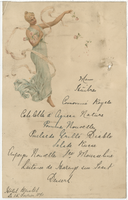
Hôtel Bristol menu, February 15, 1890
Date
1890-02-15
Archival Collection
Description
Note: Handwritten menu Restaurant: Hôtel Bristol
Text
Howard Hawks director contracts and correspondence, 1931 July 14 to 1932 July 20
Level of Description
File
Archival Collection
Howard Hughes Film Production Records
To request this item in person:
Collection Number: MS-01036
Collection Name: Howard Hughes Film Production Records
Box/Folder: Box 516 (Restrictions apply)
Collection Name: Howard Hughes Film Production Records
Box/Folder: Box 516 (Restrictions apply)
Archival Component
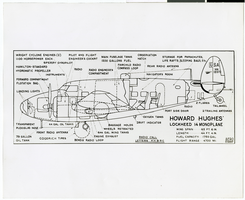
Photograph of a diagram of Howard Hughes' Lockheed 14 monoplane, July, 11, 1938
Date
1938-07-11
Archival Collection
Description
A diagram of Hughes' record-making Lockheed Plane. Typed on a piece of paper included with the image:"Pictured above is a diagram showing the construction and the special features of the Lockheed 14 monoplane in which Howard Hughes and his picked crew of four made their record flight from New York City to Paris, France, on their dash around the world. Credit line (Aero Digest from ACME) 7/11/1938."
Image
New York City 2002 calendar, 2002
Level of Description
File
Archival Collection
New York-New York Hotel and Casino 9-11 Heroes Tribute Collection
To request this item in person:
Collection Number: MS-00459
Collection Name: New York-New York Hotel and Casino 9-11 Heroes Tribute Collection
Box/Folder: Oversized Box 487
Collection Name: New York-New York Hotel and Casino 9-11 Heroes Tribute Collection
Box/Folder: Oversized Box 487
Archival Component
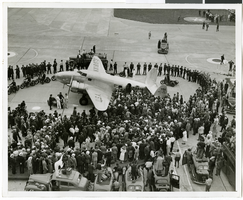
Photograph of crowds at Floyd Bennett Airfield, New York, July 14, 1938
Date
1938-07-14
Archival Collection
Description
The black and white view of Howard Hughes' Lockheed 14 aircraft after performing its final landing on the Round the World flight at Floyd Bennett Airport, New York. Description printed on photograph's accompanying sheet of paper: "Police circle Lockheed-14 at Floyd Bennett Airport."
Image
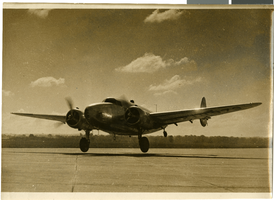
Photograph of Howard Hughes after arriving in Minneapolis, Minnesota, July 14, 1938
Date
1938-07-14
Archival Collection
Description
The black and white view of the Lockheed 14 aircraft in Minneapolis, Minnesota. Description written on the back of the photograph: "Like a Bouncing Ball, Howard Hughes landed at Minneapolis at 7:30 a.m., quickly refueled, and has off for New York at 8:11 a.m."
Image
Pagination
Refine my results
Content Type
Creator or Contributor
Subject
Archival Collection
Digital Project
Resource Type
Year
Material Type
Place
Language
Records Classification
